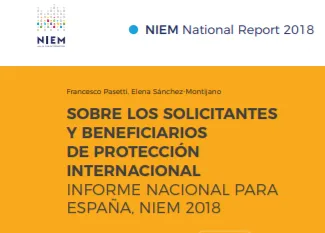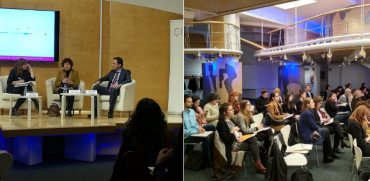Challenges and limitations of the Spanish asylum system

The Spanish asylum system has been unable to respond quickly and effectively to the new migration reality, according to the National Report for Spain by the National Integration Evaluation Mechanism (NIEM) project, funded by the European Commission. Led in Spain by CIDOB, this project assesses integration policies for refugees and the beneficiaries of international protection at national level in 14 European countries. The report highlights the inclusive nature of the asylum system in Spain, while showing the limits of an outdated and under-resourced system that lacks the tools with which to address today’s international protection challenges.
Is Spain on the frontline of reception and integration within the EU framework? The first results of the National Integration Evaluation Mechanism (NIEM) project, led in Spain by CIDOB, clearly show the main problems and challenges of a system that has been unable to respond quickly and effectively to the new migration reality. The Spanish asylum system’s inclusive nature makes it – at least on paper – one of Europe’s most favourable. But this open approach of asylum and refuge runs up against the reality of an outdated and under-resourced system that is on the verge of collapse, and has been incapable of handling the rising numbers of applicants for international protection in Spain since the misnamed refugee crisis of 2015.
NIEM’s National Report for Spain 2018 “On the seekers and beneficiaries of international protection” provides a snapshot of the state of international protection in Spain, with particular attention given to aspects relating to reception and integration, and an assessment of this system in relation to the three main dimensions of the integration process: the legal dimension (nationality, residency and family reunification), the socioeconomic dimension (employment, education, housing, healthcare and social security) and the sociocultural dimension (language-learning, civic integration and citizen awareness).
Problems and challenges for the Spanish asylum system
The report highlights the inclusive and open approach of the Spanish reception and integration system, which assumes that each person has a range of specific needs to which the system should adapt. This individualised care is enacted through two axes of the system framework: the state reception network and complementary resources, which are framed by the so-called integration pathway.
Although Spain’s asylum system meets European standards, the report calls for a deeper and more comprehensive reflection on the approach of a system that is suffering from severe problems:
- Delays during the process and their consequences for reception and integration.
The time taken to grant status can vary between 3 months and 3 years. This is a problem that extends across the distinct phases of the process, with delays of up to 7 months before the first interview to formalise the application, and the assessment phase (fase de instrucción) easily exceeding the 6 months envisaged in law. Access to the reception system is linked to the formalisation of the request for international protection. Therefore, during these long waits for interviews applicants are deprived of access to housing and and the range of services foreseen by the reception system. The administration's attempts to support people in this situation seem insufficient. In addition, the lack of initial formalisation condemns the asylum seeker to a situation of administrative irregularity, which increases the risk of them being expelled or returned.
- Scarcity of material and non-material resources.
Lack of resources appears to be a structural problem in the asylum system. In terms of both budget and places, national asylum and refugee provisions have grown in recent years, but still fall short of meeting the levels required to address increased demand. The scarcity of resources often translates into a lack of capacity to address the specific needs of asylum seekers: to a large extent this is due to a shortage of trained staff. The report underlines the urgency of an integrated system of data collection and analytical monitoring of integration measures that assesses the efficiency of reception and integration efforts.
- Intrinsic limitations of the reception and integration system: limited access to the system, inflexibility of the integration pathway and dysfunctional governance model.
The asylum and integration system is designed for a very specific profile of people and excludes all those who do not meet these characteristics from its services and provisions. This means many people are left out.
Another problematic aspect of the reception system's design relates to its geographical restriction. The fact that the entire process must take place in the same province conflicts with migrants’ need for mobility. This need is especially critical in their first few months in a reception country, all the more so given the structural problems with the Spanish labour market.
Finally, the governance model is partial and dysfunctional, and leaves important institutional actors outside the fields of action. The failures are both vertical, with regional and local administrations being ignored, and horizontal, with a lack of organisation and communication between the different ministries involved. The report highlights the need for a more extensive and diverse national strategy that involves all interested actors, both in the central administration and in the regional and local equivalents, and which at the same time counts on the participation of actors from the third sector.
Towards a new model of asylum and refugee governance
In light of the problems identified, the report outlines some potential changes to guarantee an asylum system that meets the new migration challenges: a focus on the long term; an updated, effective and organic regulatory framework; multilevel institutional architecture; taking inspiration from good practices; and long-term sustainability and effectiveness.
The NIEM project, which CIDOB leads in Spain, began in November 2016 with the aim of improving the quality and effectiveness of the integration processes for refugees and the beneficiaries of international protection in 14 EU member states: Slovenia, Spain, France, Greece, Hungary, Italy, Latvia, Lithuania, the Netherlands, Poland, Portugal, the Czech Republic, Romania and Sweden. The partners in the project include both academic institutions and non-governmental organisations and they are led by Poland's Institute of Public Affairs.
The NIEM project seeks to develop a mechanism for evaluating policies meant to integrate asylum seekers and the beneficiaries of international protection at national level. The tool will be used to gather information, identify gaps and measure the progress of refugees' integration in the fields of housing, employment, family reunification, training, citizenship, health and political participation. The ultimate goal is to support authorities in improving integration policies, their application and the establishment of real prospects for the integration of asylum seekers and refugees. This project is funded by the Fondo de Asilo, Migración e Integración (FAMI).
NIEM’s National Report for Spain 2018 “On the seekers and beneficiaries of international protection” has been produced based on an analysis of the legislative framework in place in Spain in the asylum and refugee field, and in-depth interviews with the main actors involved in the Spanish asylum system.
